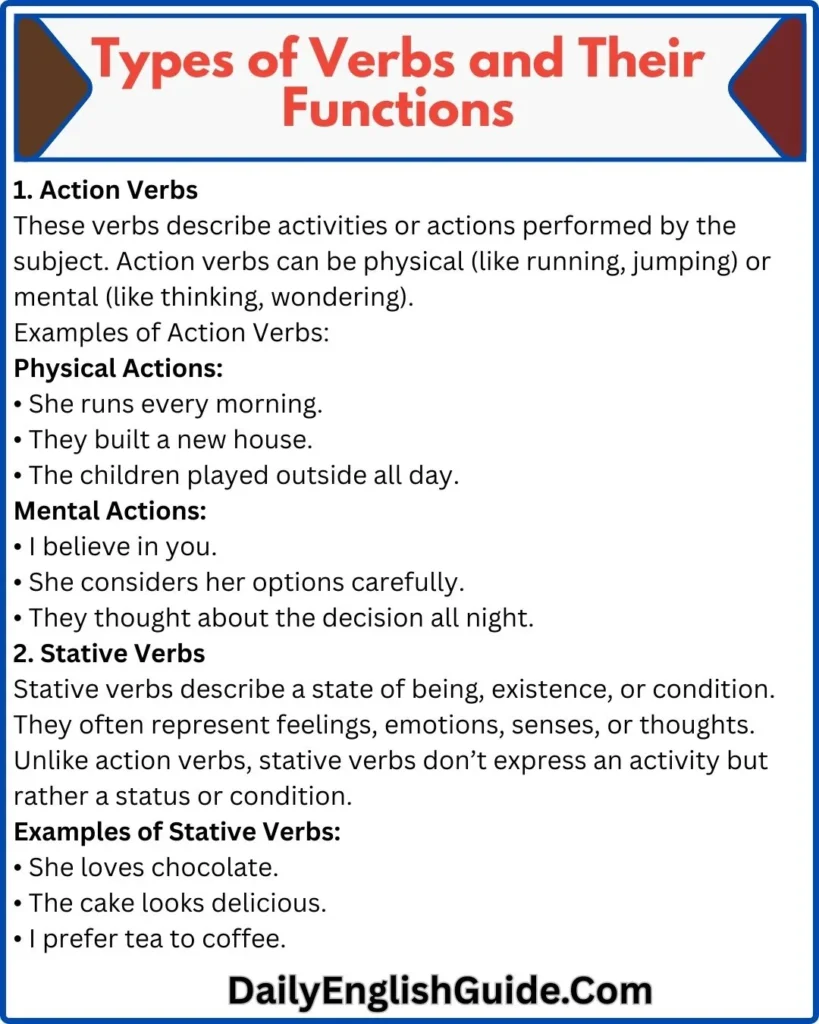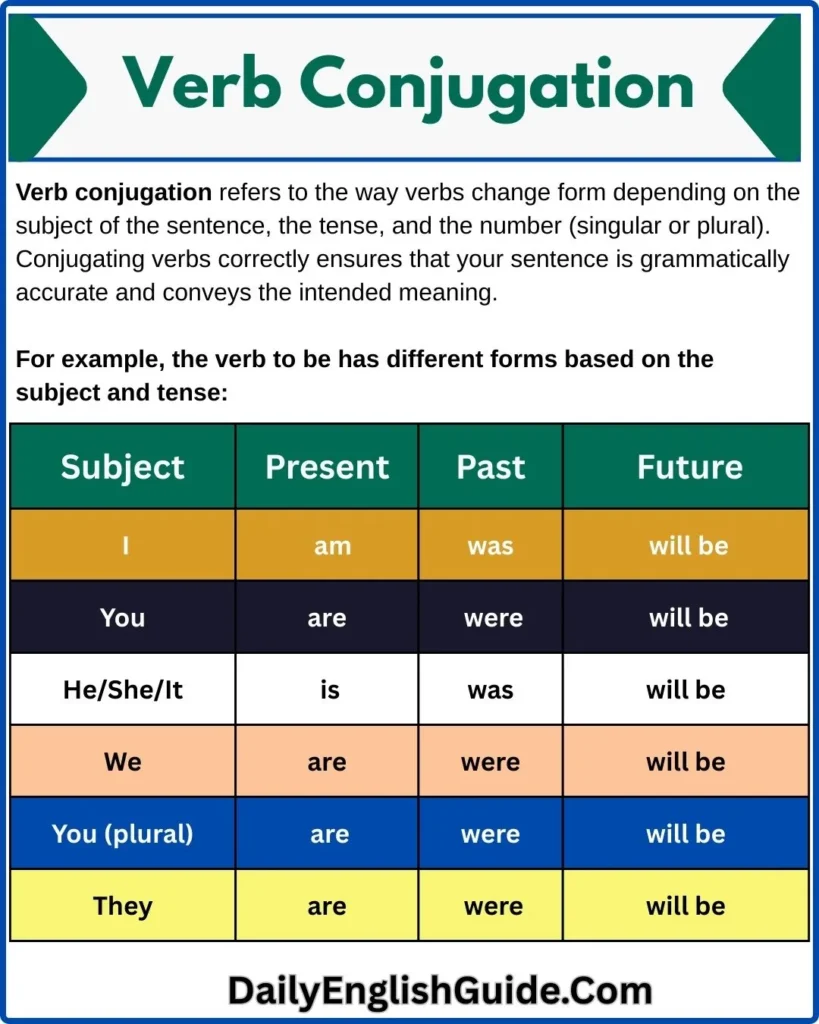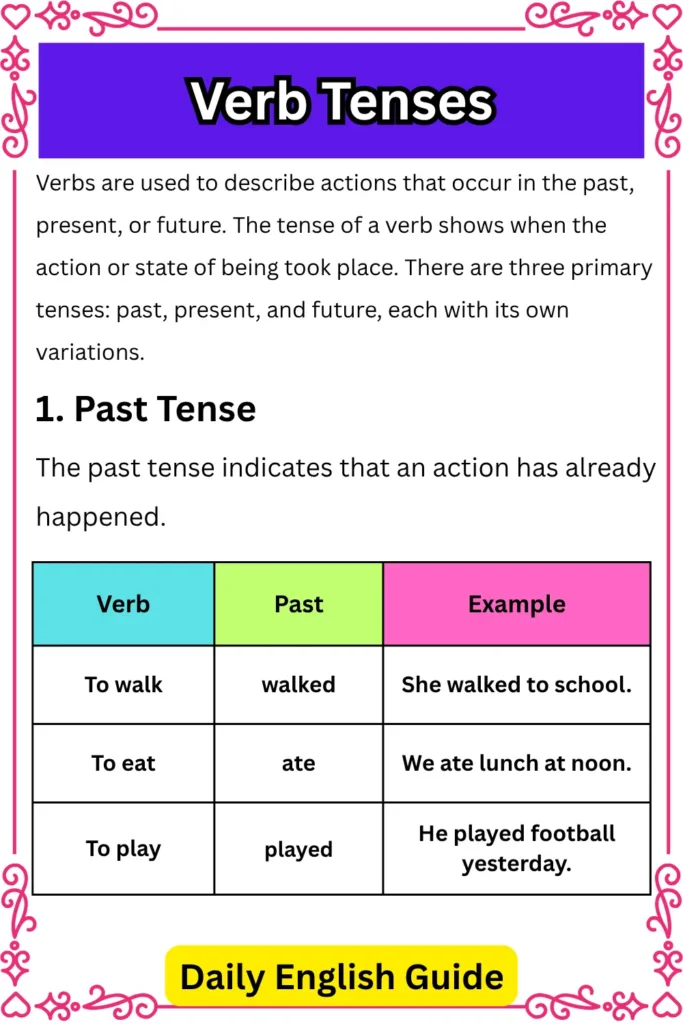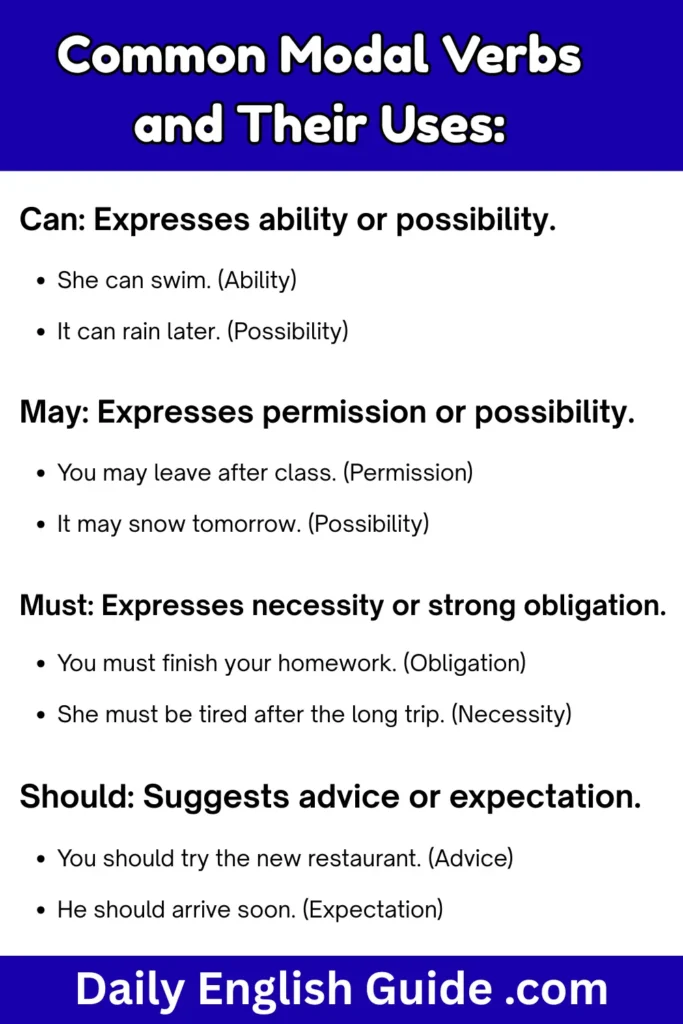Verbs are the backbone of sentences, essential for expressing actions, occurrences, and states of being. Without verbs, sentences lose their structure and meaning. As one of the most critical parts of speech, understanding verbs is foundational for anyone learning English. In this comprehensive guide, we’ll explore what verbs are, their different categories, and how they function within sentences.
What are Verbs?
In simple terms, a verb is a word that describes an action, event, or state of being. Every complete sentence in English needs a verb. Verbs allow us to convey what the subject of a sentence is doing, thinking, or experiencing. To put it succinctly: verbs are action words. However, verbs go beyond just actions—they also express mental states and existential conditions.
Key Types of Verbs:
-
Action Verbs: Represent physical or mental actions.
-
Stative Verbs: Indicate a state or condition.
-
Linking Verbs: Connect the subject of a sentence to additional information.

Types of Verbs and Their Functions
Verbs can be classified into several distinct categories. Let’s look at the most important ones:
1. Action Verbs
These verbs describe activities or actions performed by the subject. Action verbs can be physical (like running, jumping) or mental (like thinking, wondering).
Examples of Action Verbs:
-
Physical Actions:
• She runs every morning.
• They built a new house.
• The children played outside all day. -
Mental Actions:
• I believe in you.
• She considers her options carefully.
• They thought about the decision all night.
2. Stative Verbs
Stative verbs describe a state of being, existence, or condition. They often represent feelings, emotions, senses, or thoughts. Unlike action verbs, stative verbs don’t express an activity but rather a status or condition.
Examples of Stative Verbs:
• She loves chocolate.
• The cake looks delicious.
• I prefer tea to coffee.
3. Linking Verbs
A linking verb connects the subject of a sentence with additional information. The most common linking verb is to be, but others include verbs like seem, appear, become, and feel.
Examples of Linking Verbs:
• She is a teacher.
• He seems tired.
• The food smells great.
4. Auxiliary Verbs (Helping Verbs)
Auxiliary verbs accompany the main verb to help express the verb’s tense, aspect, mood, or voice. Common auxiliary verbs include have, be, and do. These verbs are crucial for constructing complex tenses and questions.
Examples of Auxiliary Verbs:
• I have finished my homework.
• She is going to the store.
• They will arrive soon.
5. Modal Verbs
Modal verbs are a type of auxiliary verb used to express ability, permission, necessity, or possibility. Modal verbs include can, could, may, might, must, should, and would.
Examples of Modal Verbs:
• You can go to the party.
• He might join us later.
• We should leave soon.
6. Phrasal Verbs
Phrasal verbs are combinations of a main verb with a preposition or particle, which often results in a meaning that differs from the individual meanings of the words. Phrasal verbs are common in English, especially in informal speech and writing.
Examples of Phrasal Verbs:
• They broke down on the highway.
• He gave up smoking last year.
• She ran into an old friend yesterday.
7. Transitive Verbs
Transitive verbs require a direct object to complete their meaning. The direct object is the recipient of the action.
Examples of Transitive Verbs:
• She ate the cake.
• He wrote a letter.
• I saw a movie.
8. Intransitive Verbs
Intransitive verbs do not require a direct object to complete their meaning. These verbs can stand alone in a sentence.
Examples of Intransitive Verbs:
• He laughed loudly.
• The bird flew away.
• She arrived late.
9. Regular and Irregular Verbs
Verbs are also classified as regular or irregular depending on how they form their past tense and past participles. Regular verbs follow a predictable pattern, typically by adding -ed or -d to the base form. Irregular verbs, however, do not follow a specific pattern and have unique past tense forms.
Examples of Regular Verbs:
• Walk → Walked → Walked
• Play → Played → Played
• Cook → Cooked → Cooked
Examples of Irregular Verbs:
• Go → Went → Gone
• Eat → Ate → Eaten
• Begin → Began → Begun
By identifying and understanding these types of verbs, learners can improve their ability to use verbs effectively in sentences. Mastery of verbs is crucial for both communication and writing fluency.
The Importance of Verbs
Verbs are essential to language as they provide the core meaning of a sentence. Without verbs, a sentence would lack action, direction, or purpose. The right choice of verb can transform a dull sentence into an exciting one. Verbs not only shape the meaning but also determine the tense, mood, and voice of a sentence, making them indispensable.
Here’s why verbs matter:
• Convey Actions: Verbs help us describe what is happening in a sentence, whether it’s something physical or mental.
• Indicate Time: Verbs indicate when an action occurs—whether it’s in the past, present, or future.
• Form Complex Sentences: By combining auxiliary and modal verbs, you can form more complex ideas and convey nuances.
• Set the Tone: The verb you choose can set the tone of your sentence, whether it’s formal, informal, urgent, or reflective.
In essence, verbs are the foundation of every well-constructed sentence, allowing for clear communication.
Understanding Verbs: Types and Categories (Continued)
In the first section, we explored the foundational aspects of verbs: their definition, types, and basic classifications. Now, let’s take a deeper dive into specific categories of verbs, and examine how they function within different contexts, along with examples to make them clearer. We’ll also discuss verb conjugation, verb tenses, and some advanced terminology to round out our understanding.

Verb Conjugation
Verb conjugation refers to the way verbs change form depending on the subject of the sentence, the tense, and the number (singular or plural). Conjugating verbs correctly ensures that your sentence is grammatically accurate and conveys the intended meaning.
For example, the verb to be has different forms based on the subject and tense:
| Subject | Present | Past | Future |
|---|---|---|---|
| I | am | was | will be |
| You | are | were | will be |
| He/She/It | is | was | will be |
| We | are | were | will be |
| You (plural) | are | were | will be |
| They | are | were | will be |
Understanding Subject-Verb Agreement
For a sentence to be grammatically correct, the subject and verb must agree in number and person. This means that if the subject is singular, the verb must also be singular, and if the subject is plural, the verb must be plural.
Examples:
• She writes a letter. (Singular subject + Singular verb)
• They write letters. (Plural subject + Plural verb)
Common mistakes in subject-verb agreement:
• Incorrect: The books is on the table.
• Correct: The books are on the table.
By mastering subject-verb agreement, you can ensure clarity and avoid basic grammatical errors in your writing.
Verb Tenses
Verbs are used to describe actions that occur in the past, present, or future. The tense of a verb shows when the action or state of being took place. There are three primary tenses: past, present, and future, each with its own variations.
1. Past Tense
The past tense indicates that an action has already happened.
| Verb | Past | Example |
|---|---|---|
| To walk | walked | She walked to school. |
| To eat | ate | We ate lunch at noon. |
| To play | played | He played football yesterday. |

2. Present Tense
The present tense shows that an action is happening now or regularly.
| Verb | Present | Example |
|---|---|---|
| To walk | walk(s) | She walks to school every day. |
| To eat | eat(s) | We eat lunch at noon. |
| To play | play(s) | He plays football every weekend. |
3. Future Tense
The future tense expresses an action that will happen later.
| Verb | Future | Example |
|---|---|---|
| To walk | will walk | She will walk to school tomorrow. |
| To eat | will eat | We will eat lunch at noon. |
| To play | will play | He will play football next Saturday. |
Perfect Tenses
Perfect tenses (present perfect, past perfect, and future perfect) express actions that have been completed or will be completed before a certain point in time.
Present Perfect:
-
I have eaten lunch.
-
They have visited the museum.
Past Perfect:
-
She had left before I arrived.
-
He had already finished his homework.
Future Perfect:
-
I will have completed the project by next week.
-
By the time you arrive, we will have left.
Verb Tenses in Context:
Understanding verb tenses is crucial for describing actions in time. Here’s how different tenses can change the meaning of the same sentence:
-
Present Tense: “I eat pizza every Friday.”
-
Past Tense: “I ate pizza last Friday.”
-
Future Tense: “I will eat pizza next Friday.”
As shown, verb tense helps to place actions in a specific time frame, adding clarity to sentences.
Active and Passive Voice
1. Active Voice
In sentences with an active voice, the subject of the sentence performs the action. The subject is the doer of the verb’s action.
Examples:
• The teacher explained the lesson. (The teacher is the subject, and they are performing the action of explaining.)
• She wrote the letter. (She is the subject performing the action of writing.)
2. Passive Voice
In passive voice sentences, the subject receives the action. In other words, the subject is acted upon, rather than performing the action.
Examples:
• The lesson was explained by the teacher. (The lesson receives the action; the teacher is the doer, but they are placed at the end.)
• The letter was written by her. (The letter receives the action of being written.)
Passive voice is useful when the focus is on the action itself or the recipient of the action, rather than the doer. However, overusing the passive voice can make sentences feel less direct or harder to follow.
Advanced Verb Concepts and Their Applications
In the previous sections, we have covered the essential concepts of verbs, including their types, conjugation, tenses, and usage in active and passive voice. Now, let’s explore more advanced aspects of verbs, such as phrasal verbs, verb complements, and participles. Additionally, we’ll delve into the critical topic of auxiliary verbs and modals and how they function in more complex sentences.
Phrasal Verbs
Phrasal verbs are a combination of a main verb and one or more particles (either prepositions or adverbs). These verbs often have meanings that differ from the individual words used in them. Understanding phrasal verbs is crucial for mastering conversational and informal English.
Examples of Phrasal Verbs:
• Break down: To stop functioning (e.g., The car broke down on the way to the airport.)
• Get over: To recover from something (e.g., She got over her illness quickly.)
• Look after: To take care of (e.g., Can you look after my dog while I’m away?)
• Run into: To meet unexpectedly (e.g., I ran into an old friend yesterday.)
Phrasal verbs can be particularly tricky because they can have multiple meanings depending on the context. They also often do not translate directly into other languages, making them challenging for learners of English.
Verb Complements
Verb complements are words or phrases that complete the meaning of a verb. These complements provide necessary information and are often in the form of a direct object, indirect object, or subject complement.
Types of Verb Complements:
-
Direct Objects: A direct object receives the action of a transitive verb.
-
She kicked the ball. (“The ball” is the direct object of the verb “kicked.”)
-
-
Indirect Objects: An indirect object indicates to whom or for whom the action is performed.
-
I gave him the book. (“Him” is the indirect object of the verb “gave.”)
-
-
Subject Complements: A subject complement follows linking verbs and provides additional information about the subject.
-
She is a doctor. (“A doctor” is the subject complement after the linking verb “is.”)
-
Verb complements help clarify the action described by the verb, making the sentence complete and meaningful.
Participles: Present and Past Forms
Participles are verb forms used as adjectives or to form verb tenses. There are two main types of participles in English: the present participle and the past participle.
Present Participle
The present participle ends in -ing and describes an ongoing action or state. It can also function as an adjective.
Examples of Present Participles:
• The barking dog kept me awake. (The participle “barking” modifies the noun “dog.”)
• I saw her running down the street. (The participle “running” describes the action of “saw.”)
Past Participle
The past participle is often used with auxiliary verbs to form perfect tenses and passive voice. It also can function as an adjective.
Examples of Past Participles:
• I have finished my homework. (The past participle “finished” is used with the auxiliary verb “have” to form the present perfect tense.)
• The broken vase lay on the floor. (The participle “broken” modifies the noun “vase.”)
Participles are crucial for creating more complex sentence structures, especially when expressing actions that have been completed or are ongoing.
Auxiliary Verbs: Understanding Their Role
Auxiliary verbs (also known as helping verbs) are used alongside main verbs to form verb phrases. They assist in expressing tense, aspect, voice, mood, and emphasis. The most common auxiliary verbs are be, have, and do.
Types of Auxiliary Verbs:
-
Be: Used for continuous tenses and passive voice.
-
She is reading a book. (Continuous tense)
-
The book was read by her. (Passive voice)
-
-
Have: Used to form perfect tenses.
-
I have finished my work. (Present perfect)
-
She had already eaten when I arrived. (Past perfect)
-
-
Do: Used to form questions, negative sentences, or to add emphasis.
-
Do you like coffee? (Question)
-
She does not understand the question. (Negative)
-
I do like coffee! (Emphasis)
-
Understanding auxiliary verbs is essential for forming questions, negations, and complex tenses.
Modal Verbs: Expressing Ability, Possibility, and Obligation
Modal verbs are a type of auxiliary verb that express modality. Modality refers to the speaker’s attitude toward the action, indicating ability, possibility, permission, or necessity.
Common Modal Verbs and Their Uses:
• Can: Expresses ability or possibility.
-
She can swim. (Ability)
-
It can rain later. (Possibility)
• May: Expresses permission or possibility.
-
You may leave after class. (Permission)
-
It may snow tomorrow. (Possibility)
• Must: Expresses necessity or strong obligation.
-
You must finish your homework. (Obligation)
-
She must be tired after the long trip. (Necessity)
• Should: Suggests advice or expectation.
-
You should try the new restaurant. (Advice)
-
He should arrive soon. (Expectation)

Examples of Modal Verbs in Action:
• She can speak three languages.
• You must wear a helmet while biking.
• I might go to the concert tonight.
Modal verbs are indispensable for expressing various shades of meaning and adding nuance to your speech and writing.
Mastering Verb Usage in English: Final Insights
In the final section of this guide, we will conclude with a review of key verb usage tips, common mistakes to avoid, and how you can continue to improve your understanding of verbs. Understanding how verbs function within sentences and their various forms will greatly enhance your ability to communicate effectively and with precision. Let’s explore these final details to wrap up our comprehensive overview.
Common Verb Mistakes to Avoid
While verbs are central to clear communication, learners often make a few common errors when using them. Recognizing these mistakes can help you become more confident in your writing and speaking.
1. Misusing Irregular Verbs
One of the most frequent mistakes involves the incorrect use of irregular verbs, especially with their past tense or past participle forms. Remember, irregular verbs do not follow the standard -ed rule for the past tense.
Examples of Irregular Verb Mistakes:
-
Incorrect: He has went to the store.
-
Correct: He has gone to the store.
-
Incorrect: She had wrote the letter.
-
Correct: She had written the letter.
To avoid such errors, it’s essential to memorize the forms of irregular verbs or use a reference guide when necessary.
2. Confusing Transitive and Intransitive Verbs
Some verbs can be both transitive and intransitive, depending on how they are used in the sentence. A transitive verb requires a direct object, while an intransitive verb does not.
Example:
-
Transitive: I read the book. (“Book” is the direct object.)
-
Intransitive: I read for an hour. (No direct object, “for an hour” is a prepositional phrase.)
It’s important to understand the difference between transitive and intransitive verbs to avoid confusion and ensure the correct structure in your sentences.
3. Incorrect Subject-Verb Agreement
This mistake happens when the subject and verb do not match in number (singular/plural) or person. It’s essential to ensure that the verb corresponds correctly with the subject of the sentence.
Examples:
-
Incorrect: The team are playing well.
-
Correct: The team is playing well.
-
Incorrect: They was late for the meeting.
-
Correct: They were late for the meeting.
To prevent this error, always double-check the subject and its corresponding verb before finalizing your sentence.
4. Overuse of Passive Voice
While the passive voice can be useful, overusing it can make your writing sound less engaging or direct. Whenever possible, try to use the active voice, where the subject performs the action.
Example of Overuse of Passive Voice:
-
Passive: The report was written by John.
-
Active: John wrote the report.
Using the active voice can often make your writing more straightforward and lively, as it emphasizes the subject performing the action.
Why Are Verbs Important?
Verbs are at the heart of sentence construction. They provide the essential action or state that gives meaning to the subject of a sentence. Without verbs, communication would be much less effective, as sentences would lack movement, purpose, or connection.
Here’s why verbs matter:
-
Clarity in Communication: Verbs define what’s happening in a sentence. Whether it’s an action or a state of being, the verb clarifies the message.
-
Expressing Tense: Verbs allow you to express when an action occurs—whether in the past, present, or future. This helps convey timing and context.
-
Building Complex Ideas: Through auxiliary verbs and modal verbs, you can create complex tenses and express nuances in mood and tone.
-
Engaging the Reader: Strong verbs make sentences more vivid, engaging, and compelling. A sentence with a clear action is much more interesting than one that relies on weak or unnecessary linking verbs.
Tips for Mastering Verb Usage
Mastering verb usage in English involves practice and attention to detail. Here are some tips to continue improving:
-
Read Actively: Pay attention to verb usage in books, articles, and conversations. Notice how verbs change based on context, tense, and subject.
-
Practice Writing: Write sentences and short paragraphs focusing on using a variety of verbs. Try to incorporate different verb types and tenses into your writing.
-
Use Resources: Keep a reference guide for irregular verbs or a list of common phrasal verbs handy. This will help reinforce correct usage.
-
Ask for Feedback: Share your writing with others and ask for feedback on your verb usage. Constructive criticism will help you spot mistakes you might not have noticed.
-
Use Grammar Tools: Leverage grammar checkers to identify common verb mistakes, especially with subject-verb agreement and tense usage.
Final Thoughts
Verbs are the cornerstone of grammar. Understanding their different forms, uses, and complexities allows for effective communication. Whether you’re writing or speaking, a strong grasp of verbs will help you convey your ideas with clarity, precision, and flair. With practice and attention to detail, mastering verbs will significantly enhance your command of the English language.
